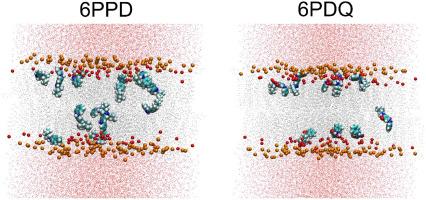Effect of rubber pollutants 6PPD and 6PDQ on a complex membrane
IF 5.4
2区 医学
Q1 BIOCHEMISTRY & MOLECULAR BIOLOGY
引用次数: 0
Abstract
Rubber products have been widely used with the development of industrial production, and hundreds of thousands of tons of the antioxidant and antiozonant molecule 6PPD has been widely used in their manufacture. The reaction of 6PPD with oxygen or ozone produces 6PDQ, and both 6PPD and 6PDQ has been shown to be toxic to living organisms. 6PPD and 6PDQ are hydrophobic and could insert into the biological membrane, and therefore able of affecting membrane structure and lipid components. I employed molecular dynamics to attain the behaviour of 6PPD and 6PDQ in a complex biomembrane. Both 6PPD and 6PDQ spontaneously insert into the membrane and can reside at different membrane depths, always in the monomeric state. 6PDQ, in some instances, attach to the membrane surface and move into the membrane, whereas in other instances insert into the membrane surface and leave it again at later times, without inserting into the membrane. 6PPD and 6PDQ insert between the phospholipids, increasing their fluidity. 6PPD and 6PDQ avoid PSM or CHOL and do not form hydrogen bonds with lipids, indicating that their displacement inside the membrane is not constrained by any form of interaction. Therefore, 6PPD and 6PDQ spontaneously insert into the biological membrane, affecting its physico-chemical properties. The insertion of 6PPD and 6PDQ into the biological membrane might be responsible for some of their harmful effects on living organisms.

橡胶污染物6PPD和6PDQ对复合膜的影响
随着工业生产的发展,橡胶制品得到了广泛的应用,数十万吨的抗氧化剂和抗臭氧剂分子6PPD已被广泛应用于其制造中。6PPD与氧或臭氧反应产生6PDQ, 6PPD和6PDQ已被证明对生物体有毒。6PPD和6PDQ是疏水性的,可以插入到生物膜中,因此可以影响膜结构和脂质成分。我使用分子动力学来获得6PPD和6PDQ在复杂生物膜中的行为。6PPD和6PDQ都可以自发地插入到膜中,并且可以驻留在不同的膜深度,始终处于单体状态。在某些情况下,6PDQ附着在膜表面并移动到膜中,而在其他情况下,插入膜表面并在稍后离开膜,而不插入膜中。6PPD和6PDQ插入磷脂之间,增加其流动性。6PPD和6PDQ避免PSM或CHOL,也不与脂质形成氢键,表明它们在膜内的位移不受任何形式的相互作用的限制。因此,6PPD和6PDQ会自发地插入到生物膜中,影响其理化性质。6PPD和6PDQ插入生物膜可能是它们对生物体的一些有害影响的原因。
本文章由计算机程序翻译,如有差异,请以英文原文为准。
求助全文
约1分钟内获得全文
求助全文
来源期刊
CiteScore
7.70
自引率
3.90%
发文量
410
审稿时长
36 days
期刊介绍:
Chemico-Biological Interactions publishes research reports and review articles that examine the molecular, cellular, and/or biochemical basis of toxicologically relevant outcomes. Special emphasis is placed on toxicological mechanisms associated with interactions between chemicals and biological systems. Outcomes may include all traditional endpoints caused by synthetic or naturally occurring chemicals, both in vivo and in vitro. Endpoints of interest include, but are not limited to carcinogenesis, mutagenesis, respiratory toxicology, neurotoxicology, reproductive and developmental toxicology, and immunotoxicology.

 求助内容:
求助内容: 应助结果提醒方式:
应助结果提醒方式:


